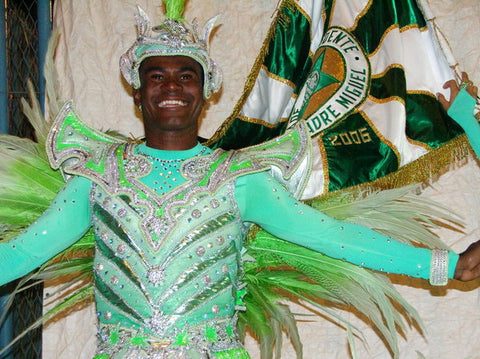Mestre Sala - Samba Host
Posted on 21 February 2019
In this section, we will talk about a characteristic figure within the Brazilian Carnaval festivity: the Mestre-Sala, translated to Samba-Host. Below, you will understand why this iconic element is able to symbolize the essence and honor of the Carnaval culture. This figure, just like the Flag-Bearer, can represent the highest distinction to individuals who have devoted their career and lives to Carnaval and Samba in Brazil.
Watch below a very cool Carnival Video of Mestre Sala performance, at the end of this page.
The Brazilian carnaval figure/element that pairs with the Porta-Bandeira- Flag bearer in Brazilian Carnaval parade is the Samba-Host. His main artistic function during the parade whilst courting his flag-bearing partner, is to protect the Porta-bandeira and the banner of the samba school. Symbolically, the Mestre-Sala carries a handkerchief or fan. Carnaval historians note that in the past, razors and small knives were concealed within the fans/handkerchiefs and would be readily used if someone tried to steal the samba-school banner.
Below, mestre-sala Rogerinho, that used has danced for Mocidade and Unidos da Tijuca samba-school, and today represents Portela. As you can see, his clothing is very rich and detailed.

Photo Credit: Diogo Mendes
The second distinguishing attribution of the Mestre-sala is to draw everyone’s attention to his protégée and make sure the samba-school banner/flag itself, attracts media and popular awareness during a parade. He wants to make sure the Porta-Bandeira will be positively evaluated, and samba-school´s banner highlighted. Unlike other samba dancers, his choreography is refined and delicate, resembling the court dances of France aristocratic palaces. Some samba-dance experts say both should “slide” during the official samba parade. The samba-host costume also resemble those elegant clothing worn on European mid 18th century saloons, including a wig.
Both porta-bandeira / mestre-sala roles in the carnival culture can really mean the top of a career and life devoted to samba. Most couples you see at Rio de Janeiro and São Paulo carnaval parades have probably been dancing and practicing samba for at least 15-20 years. They usually start practicing for that specific function very young, at the ages of 8-10 years and gradually move up the samba-school hierarchy. Many of them are direct descendants of the true founders of carnaval and samba in Brazil. The couples develop their skills and experience, hoping one day to belong to become the “couple number 1”, from one of the 12 most important samba-schools of Rio. The achievement of these positions would naturally bring them fame and glory.
First Couple is what we define as the number 1 Mestre Sala and Porta-Bandeira ( Flag-bearer) of a samba-school. Here we see Ana Paula and Robson from Imperio Serrano Samba School, getting ready to enter the Sambadrome.
Photo Credit Diogo Mendes
Now some final facts:
- Today, due to the professionalization of Brazilian Carnival, we can find specific teachings for this type of choreography (Samba-host & Porta-Bandeira routines), where they can enhance their dance, artistic, and even acting skills.
- In a major samba-school parade, you can have up to 3 couples of Mestre-Sala / Porta-Bandeira per school. The official carnival judges naturally only rate the best couple and logically the most qualified of the school, called appropriately the “first couple".
- The second and even third couples also play significant roles during the official contest. They are the future generations of these specific functions and take the opportunity of the official event to gain experience, charisma, graciousness so that one day they can become “couple number 1”.
- Today, the contracts of these professionals have increased significantly in terms of pay, since samba-schools will always try to have the best Samba Hosts, to make sure they obtain the perfect score for this contest criterion.
- The Mestre Sala costume can also cost up to US$ 15.000,00 or more per year.







